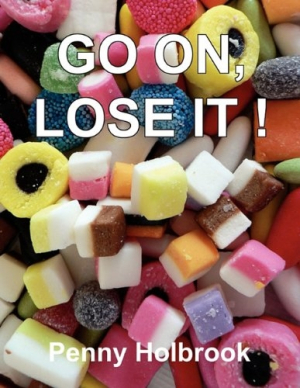Go On, Lose It!
Penny Holbrook, a British nurse and eating disorders counselor, wrote Go On, Lose It! as a tool for assisting her clients with their weight loss and self-improvement goals through a program she calls “Changing Shape.”
The glossy, oversized book appears to have been written and produced in a rush, as there are a multitude of typographical and grammatical errors, as well as other unfortunate issues that overshadow its strengths. The cover is amateurishly designed, and the back-cover copy is difficult to read.
The most prominent problem is that Go On, Lose It! reads like a handbook for Holbrook’s personal clients, especially in the opening sections. For example, Holbrook writes, “Changing Shape is not just another slimming diet. It has a unique concept of integrating counselling support with an individual weight loss programme tailored to each client, combined with exercise and other aspects concerning appearance and well being.” Furthermore, Go On, Lose It! is written with idioms, measurements, consumer products, and cultural contexts that are common to the United Kingdom, but likely to be unfamiliar to some American readers. The most significant examples of British English can be found in the recipes at the end of the book, where grams and dessert spoons are used for quantities, and courgettes and aubergines are ingredients. To make matters worse, none of the recipes seem particularly appealing or interesting, and many appear high in sodium, unhealthy fats, and simple carbohydrates.
However, there are several excellent aspects of Go On, Lose It! that bear mentioning. First, Holbrook’s writing style is very friendly and inclusive. She obviously has a strong and empathetic rapport with her clients that translates well onto the printed page. The book sports an abundance of useful, inspirational, and potentially quite effective tools for weight loss and improving one’s self-image. A tremendous focus is put on methods for changing unhealthy habits, as well as educating the reader about how the body processes food; two points that coincide with recent research about what works for maintaining one’s weight after shedding pounds. Holbrook’s expertise in treating eating disorders is also evident throughout the book, and she cleverly focuses more on compulsive eating rather than getting bogged down by the complexities of bulimia and anorexia nervosa.
Holbrook’s clients and British readers seeking an easy-to-read primer about diet and self-improvement will find this a book worth acquiring.
Reviewed by
Patty Sutherland
Disclosure: This article is not an endorsement, but a review. The publisher of this book provided free copies of the book and paid a small fee to have their book reviewed by a professional reviewer. Foreword Reviews and Clarion Reviews make no guarantee that the publisher will receive a positive review. Foreword Magazine, Inc. is disclosing this in accordance with the Federal Trade Commission’s 16 CFR, Part 255.

